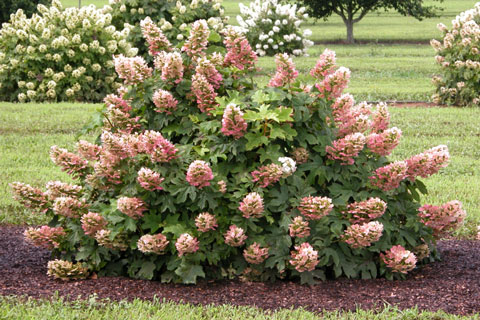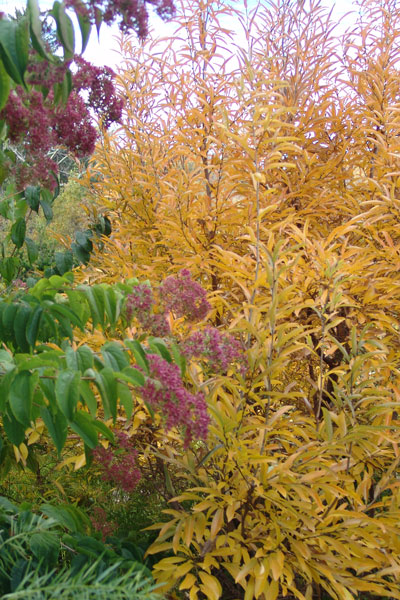7/1/2021
Bring on the Fall Color
Andrew Bunting
One of my favorite shrubs for fall color is Disanthus cercidifolius, which is an upright, multi-stemmed shrub from China. The epithet implies Cercis or redbud-like leaves that are heart shaped and ultimately turn to pink to burgundy and often fire engine red in the fall.
Also, sporting excellent red fall color is a selection of the chokeberry, Aronia arbutifolia Brilliantissima, which is grown for its white flowers in the spring, an abundance of bright red berries that attract wildlife and birds, and its “brilliant” red fall color. This multi-stemmed native shrub can survive in both wet and dry conditions, and exhibits the best fall color in full sun.
With shades of red, burgundy and purple, Itea virginica Henry’s Garnet is an excellent native shrub for fall color. It, too, can grow in a variety of conditions, including very wet conditions. This East Coast native has amazing bottlebrush-like, fragrant flowers that cover this 4- to 5-ft. tall shrub in May through June. It’s aptly referred to as the Virginia sweetspire. Other excellent selections include a more diminutive form, Little Henry, and Merlot with deeper burgundy fall color.
Deer-Resistant Options
I’m always in search of any plants that truly possess a resistance to deer browsing. The bottlebrush buckeye, Aesculus parviflora has these traits. This is a colonizing shrub (spreading by underground stems) that can reach a fairly large stature over time. I’ve seen many decades-old masses that are at least 30- to 50-ft. wide and probably 20-ft. tall, but this size develops over time. In its youth, it thrives growing in full sun or colonizing in a shady garden.
This native shrub has palmately compound leaves, and in early summer, long, wand-like flowers emerge and sit like large white candles above the foliage. The flowers are attractive to myriad butterflies. In the autumn, the fall color is a brilliant golden-yellow. Aesculus parviflora var. serotina Rogers has larger flowers and comes into flower about three weeks later than the species.
Another favorite for golden fall color are the summersweets, Clethra alnifolia. Like Itea virginica and Aronia arbutifolia, this spreading shrub can also take damp conditions in the garden. When I drive east through New Jersey during the summer, I see clethra peeking out from the edge of the woods growing in swamp-like conditions. It’s primarily grown for its spire-like flowers in late summer that are white and fragrant. Selections such as Ruby Spice have an abundance of pink flowers. In the fall, the leaves turn bright yellow, which adds to the ornamental interest of this medium-sized shrub.
Underused in the garden and landscape is the native spicebush, Lindera benzoin. This understory shrub is found throughout the Eastern deciduous forests and, like the bottlebrush buckeye, has complete resistance to deer pressure. All lindera species have alkaloids in their stem and leaf tissue, which are unappetizing to deer.
Lindera benzoin has small clusters of yellow flowers in early spring that emerge before the leaves emerge, and in the fall, golden leaves brighten the darkest corners of the shade garden. In my home garden is an Asian counterpart, Lindera obtusiloba. This is one of the best-of-the-best when it comes to shrubs with exceptional fall color. This spicebush has leaves similar to Sassafras albidum, in that it has a variety of leaf shapes, from entire to tri-lobed to mitten shaped. These leaf types create a bold texture in the garden. Like Lindera benzoin, flowers emerge before the leaves in the spring. In the case of Lindera obtusiloba, the flower clusters are larger and more robust. In the fall, these large leaves turn an amazing, vivid, golden yellow.
A Few More O ptions
ptions
A discussion on fall color and spicebushes wouldn’t be complete without including Lindera glauca var. salicifolia, which is another Asian species. I have this in my front yard where there’s intense deer pressure and it goes unscathed. The fall color is truly amazing. The leaves transition from yellow-orange to a stunning pumpkin-orange, and ultimately turn to taupe and remain on the plant until the following spring when they eventually fall off. While this shrub is still relatively obscure, it has gained in popularity with some landscape designers, and it’s only a matter of time before it gains in popularity at the garden center and with the home gardener.
Pictured: Both Lindera glauca var. salicifolia (top) and Hydrangea quercifolia Ruby Slippers (bottom) offer multiple seasons of interest and color.
While all hydra ngeas are ultimately grown for their flowers, the oakleaf hydrangea (Hydrangea quercifolia) also has exceptional fall color that can range from red to purple. It’s called the oakleaf hydrangea because of the leaves that resemble large red, oak-like leaves. There are many old and new selections all worthy of consideration. For years, the best cultivar has been Snow Queen, which has an abundance of white cone-like clusters of flowers in mid-summer.
ngeas are ultimately grown for their flowers, the oakleaf hydrangea (Hydrangea quercifolia) also has exceptional fall color that can range from red to purple. It’s called the oakleaf hydrangea because of the leaves that resemble large red, oak-like leaves. There are many old and new selections all worthy of consideration. For years, the best cultivar has been Snow Queen, which has an abundance of white cone-like clusters of flowers in mid-summer.
Snowflake has double hose-in-hose flowers that weigh down the flowers and make them droop or pendant. Sikes Dwarf is a diminutive selection and Ruby Slippers is also a good candidate for the small garden. Amethyst has flowers that are carmine to red. Gatsby Pink has flowers that quickly change from white to pink and has a medium-sized stature.
Orixa japonica has an interesting ghost-like nearly white fall color. It’s a stunning addition to the woodland garden and is deer proof! The multi-stemmed shrub can reach 12-ft. tall. A great variegated cultivar is Pearl Frost, which is gaining in popularity.
These are a few of my favorites, but there are literally hundreds of excellent shrubs with multi-seasons of interest that have great fall color. GP
Andrew Bunting is the Vice President of Public Horticulture for the Pennsylvania Horticultural Society, which uses horticulture to advance the health and well-being of the Greater Philadelphia region. Andrew has decades of horticultural experience, ranging from his tenures at public gardens in the U. S. and abroad, as well as a published author, gardening expert and sought-after presenter. To learn more about PHS or to become a member and support greening initiatives in over 250 neighborhoods, visit PHSonline.org.